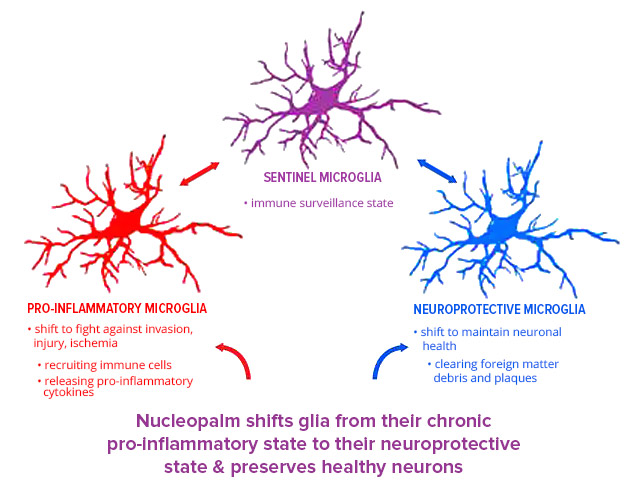
What to expect with Nucleopalm
Nucleopalm is a proprietary patented product designed to correct underlying pathology of chronic nerve pain. Unlike conventional treatments (pregabaline & gabapentine) Nucleopalm is devoid of any side effects. Conventional treatments are known to cause dizziness and sleepiness in about 70% of cases making it non-compliant. Nucleopalm is devoid of any adverse drug reactions.
Nucleopalm exhibits three prong actions
2
3
In clinical trials, some patients started feeling less chronic diabetic nerve pain as early as the 2nd week of treatment. For others, it took longer, and individual results may vary

Other Conditions Nucleopalm Treats
Whether you’ve been suffering for several years or just been diagnosed with any of the conditions listed below, Nucleopalm may be able to help. Nucleopalm is believed to work on damaged nerves for specific conditions apart from diabetic and chronic idiopathic neuropathy. Remember to talk to your doctor and ask if Nucleopalm could be right for you.
About Fibromyalgia Pain
Learn more about the chronic, widespread pain of fibromyalgia
Fibromyalgia is a specific kind of pain that’s chronic, widespread, and often accompanied by tenderness.
CHRONIC
The pain lasts a long time—at least 3 months or longer. Many people experience fibromyalgia pain for years before being diagnosed.
WIDESPREAD
The pain is felt all over, in both the upper and lower parts of the body. However, many people with fibromyalgia feel their pain in specific areas of their body, such as in their shoulder or neck.
TENDERNESS
Even a small amount of pressure can cause a lot of pain.
About Sciatica Pain
Learn more about the chronic, radiating pain of Sciatica
Sciatica refers to pain that radiates along the path of the sciatic nerve, which branches from your lower back through your hips and buttocks and down each leg. Typically, sciatica affects only one side of your body.
Sciatica is caused by irritation of the root(s) of the lower lumbar and lumbosacral spine. Additional common causes of sciatica include: Lumbar spinal stenosis (narrowing of the spinal canal in the lower back) Degenerative disc disease (breakdown of discs, which act as cushions between the vertebrae)
About Carpel Tunnel Syndrome Pain
Learn more about Paresthesia Hypoesthesia Pain
Carpal tunnel syndrome is a common condition that causes pain, numbness, and tingling in the hand and arm. The condition occurs when one of the major nerves to the hand — the median nerve — is squeezed or compressed as it travels through the wrist.
Symptoms: Paresthesia Hypoesthesia Pain
How is carpal tunnel syndrome diagnosed?
- Tinel's sign. In this test, the physician taps over the median nerve at the wrist to see if it produces a tingling sensation in the fingers
- Wrist flexion test (or Phalen's test)
- X-rays
- Electromyography (EMG) and nerve conduction studies.
About Spinal Cord Injury Pain
If you have spinal cord injury nerve pain, make sure to ask your doctor about Nucleopalm and how it may be able to help relieve your pain.
What are the symptoms of spinal cord injury nerve pain?
People have many ways of describing the distinct feeling of nerve pain from spinal cord injury. The most common symptoms of spinal cord injury are
Burning Numbness Throbbing Sharp Pain Tingling Stabbing Electric shock-like
